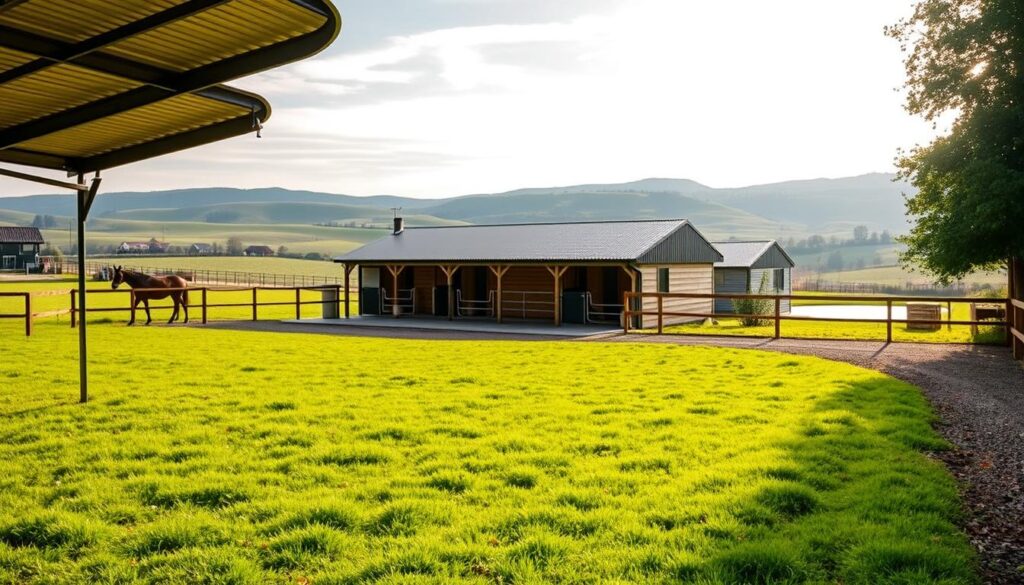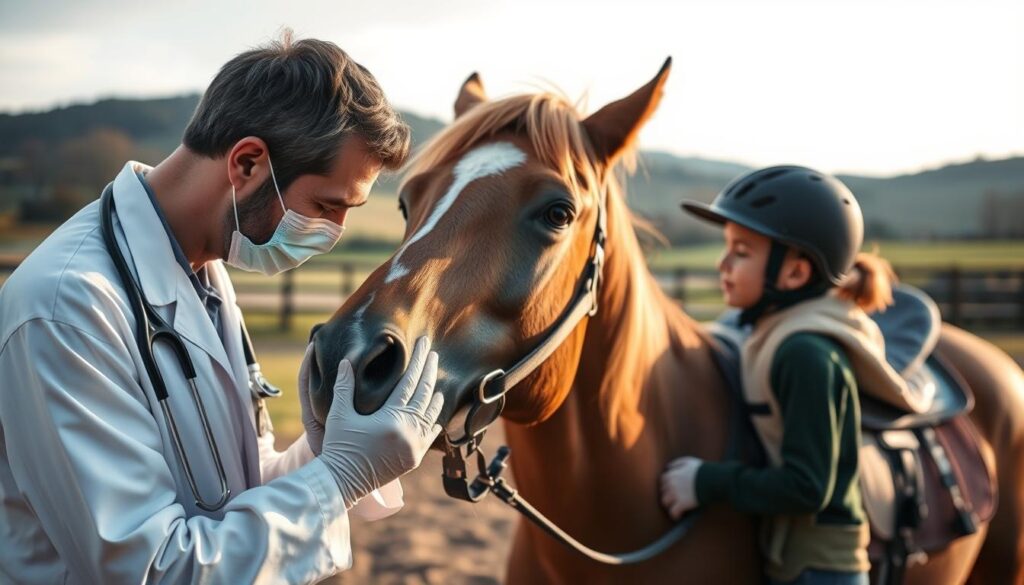Selecting a boarding facility for your companion is more than just finding shelter – it’s creating a second home where trust and safety matter. Like choosing a school for a child, every detail impacts their well-being. Barns with experienced staff, clean stalls, and quality hay aren’t luxuries; they’re necessities.
Many new owners don’t realize boarding options range from self-care setups to full-service operations. Climate-controlled barns in Canada might offer winter riding arenas, while pasture-based facilities prioritize outdoor access. Daily routines, emergency protocols, and feed quality vary wildly between properties.
This guide cuts through the confusion. You’ll learn how to evaluate contracts, spot red flags in stable management, and balance costs with your animal’s needs. We’ve gathered insights from equine veterinarians and seasoned barn managers to help you make informed decisions.
Key Takeaways
- Boarding facility selection directly impacts equine health and behavior
- Full-service options often include feed, stall cleaning, and turnout
- Riding arenas and secure fencing are critical safety features
- Written agreements prevent misunderstandings about care responsibilities
- Barn culture significantly affects both animals and owners
Understanding Horse Boarding Options
Your equine companion’s comfort depends on matching their needs with a care plan that suits your schedule. Facilities range from hands-off setups to properties where staff handle every detail. Let’s break down what each choice means for you and your animal.
Self-Care vs. Full Board: What’s Included?
Self-care means you’re responsible for daily tasks like feeding, stall cleaning, and turnout. This option often costs less but requires regular visits—ideal for owners who want direct involvement. You’ll bond through shared routines but need reliable transportation to the property.
Full board offers convenience. Staff manage feeding schedules, stall maintenance, and exercise routines. Perfect for busy schedules, it ensures consistent care even when you can’t visit. Many barns include extras like blanket changes or hoof pick checks in their packages.
| Feature | Self-Care | Full Board |
|---|---|---|
| Cost | $300–$500/month | $600–$1,200/month |
| Time Commitment | Daily visits | Weekly check-ins |
| Services Included | Basic stall | Feeding, cleaning, turnout |
| Best For | Hands-on owners | Professionals, families |
Finding Your Care Rhythm
Self-care builds strong bonds but demands 1–2 hours daily. Full board lets you focus on riding while staff handle chores. Tip: Visit during feeding times to observe how workers interact with animals. Does the barn rotate pastures? How often do they refresh hay?
Consider travel distance and facility protocols. A barn 30 minutes away might work for full board, but self-care becomes impractical. Always review contracts—some require vaccіnation records or charge extra for holding during vet visits.
Choosing the Right First Time Horse Boarding Facility
Location plays a starring role in your animal’s quality of life—and your sanity. A well-placed property keeps your visits frequent and stress-free while ensuring swift access during emergencies.
Why Distance Matters More Than You Think
Short drives save hours monthly. Facilities within 20 minutes of home make daily check-ins practical. Longer commutes drain fuel budgets and limit spontaneous visits.
| Drive Time | Monthly Visits | Annual Fuel Cost* |
|---|---|---|
| 15 minutes | 30 | $240 |
| 45 minutes | 12 | $1,100 |
| 60+ minutes | 6 | $2,400 |
*Based on Canadian gas prices & mid-size vehicle
Community Vibes Matter
Safe neighborhoods with low crime rates protect equipment and animals. Chat with nearby residents—do they notice well-maintained pastures? Are delivery trucks frequent on access roads?
Visit during Saturday mornings to see how parking holds up. Watch how staff manage icy winter paths or summer storm drainage. These details reveal year-round usability.
Ask current boarders about local vet response times. Properties near equine clinics often get priority emergency care. Always confirm after-hours gate access codes too!
Evaluating Boarding Facilities and Amenities
Your animal’s daily environment shapes their health and happiness. Walk through properties with a detective’s eye—quality care hides in the details you might overlook at first glance.
Assessing the Cleanliness and Stall Conditions
Well-kept stalls prevent respiratory issues and hoof problems. Look for 12×12-foot spaces with dry bedding—pine shavings or straw work best. Sniff for ammonia odors, which signal infrequent cleaning.
Check feed storage areas for mold-free hay and sealed grain bins. Proper ventilation matters—open windows or fans reduce dust buildup. A barn manager shared: “We replace bedding daily and power-wash stalls weekly to prevent bacteria growth.”
Pasture Size, Turnout Opportunities, and Safety
Grasslands should offer 1–2 acres per animal with shaded areas. Inspect fencing—wood or vinyl posts withstand Canadian winters better than wire. Look for smooth edges and secure gates to prevent injuries.
Watch how staff handle turnout rotations. Consistent schedules reduce stress, while mixed herds need careful monitoring. Test water troughs—automatic heaters prevent ice buildup, and clean containers stop algae blooms.
Chat with boarders during your visit. Ask:
- How quickly do workers address maintenance requests?
- Are pastures dragged regularly to manage manure?
- Do they provide fly spray in summer months?
Factors Influencing Boarding Costs and Location Considerations
Understanding the financial landscape of equine care helps prevent sticker shock while ensuring quality. Monthly fees swing wildly based on geography—urban centers like Toronto often charge 60% more than rural Alberta properties. Why? Land values and operational expenses shape pricing structures.

Budgeting for Boarding Fees and Additional Expenses
Basic care packages start around $200 monthly in Manitoba’s countryside, while full-service Ontario barns near cities hit $600+. Facilities with indoor arenas or specialized footing add 15–20% to base rates. Always ask about:
- Grain supplements ($25–$50/month)
- Blanketing services ($15/application)
- Trailer parking fees ($40–$100)
Transport eats budgets faster than mice in a feed room. Boarding near major highways saves fuel, but rural properties might require 4WD winter access. One Saskatchewan owner shared: “My $350/month pasture board became $600 after adding snowplow charges and emergency vet mileage.”
| Region | Average Monthly Cost | Common Extras |
|---|---|---|
| Urban BC | $550–$800 | Heated wash bays, security cameras |
| Rural Quebec | $250–$400 | Pasture rotation, DIY storage |
Smart boarders compare at least three facilities. Check water quality reports—mineral-heavy wells require supplemental salt blocks. Review manure removal schedules; some barns charge $75/load for disposal. Remember: cheaper options often mean you’re the backup caretaker during staff shortages.
Building a Positive Experience: Barn Culture and Care Tips
A thriving barn environment acts as the backbone of successful equine care. Clear communication and shared values create spaces where animals and people flourish. Let’s explore how thoughtful agreements and community connections elevate daily routines.
Understanding Barn Rules, Contracts, and Staff Roles
Written agreements protect everyone involved. Review contracts for details about feed schedules, emergency protocols, and liability coverage. One Ontario barn manager notes: “Our 12-page document clarifies everything from farrier access to storm evacuation plans – no surprises.”
Staff expertise directly impacts animal well-being. Ask about training programs for workers handling medications or injury care. Facilities with certified equine nutritionists often tailor diets to individual needs.
| Contract Element | Why It Matters | Red Flags |
|---|---|---|
| Fee Structure | Prevents hidden charges | Vague “miscellaneous” fees |
| Staff Responsibilities | Defines care standards | Unclear emergency roles |
| Termination Clauses | Protects during disputes | 30+ days notice required |
Engaging with Fellow Boarders and Cultivating Community
Shared knowledge makes barn life richer. Seasoned owners often teach newcomers about seasonal coat care or local vet recommendations. Weekly group rides or clinics foster camaraderie while improving skills.
“Our monthly potluck solved more training challenges than any manual,” laughs a Manitoba boarder. Respectful communication resolves most conflicts – discuss turnout preferences or arena schedules openly.
“Ask about social events during tours. Barns that host educational workshops usually prioritize collective growth.”
Transparent operations build trust over time. Properties sharing inspection reports or feed invoices demonstrate commitment to quality. Remember: a welcoming culture benefits both two-legged and four-legged residents.
Preparing Your Horse for Board: Health, Training, and Socialization
Transitioning your equine partner to a new home requires thoughtful preparation beyond packing tack. A smooth adjustment hinges on medical readiness and social adaptability. Start planning 4–6 weeks before moving day to address potential hurdles.

Health Screenings, Vet Check-Ups, and Routine Care
Up-to-date vaccinations are non-negotiable. Most Canadian facilities require proof of rabies, West Nile, and equine influenza shots. Schedule a dental float and hoof trim within 30 days of relocation—sharp edges or long toes complicate eating and movement.
Request fecal egg count tests to confirm deworming effectiveness. “We’ve seen strangles outbreaks traced to asymptomatic carriers,” warns an Alberta equine veterinarian. Bloodwork for Coggins tests satisfies cross-border travel requirements too.
| Check-Up | Frequency | Cost Range (CAD) |
|---|---|---|
| Vaccinations | Annual | $150–$300 |
| Dental Exam | 6–12 months | $80–$200 |
| Hoof Care | 6–8 weeks | $40–$80 |
Acclimating Your Horse and Encouraging Interaction
Introduce new herd members over fences first. Supervised turnout sessions prevent bullying while establishing hierarchy. Bring familiar items like salt licks or stall toys to ease anxiety.
Monitor water intake closely—strange tastes sometimes deter drinking. Adding apple slices or electrolytes can help. Stick to original feeding times initially, then gradually align with barn schedules.
- Practice loading/unloading trailers if moving off-site
- Expose to varied noises (tractors, radios) beforehand
- Schedule arrival during quiet weekday hours
Watch for subtle stress signs: reduced manure output or excessive pawing. Most animals adjust within 10–14 days. Keep initial training sessions short and positive—confidence builds through small wins.
Conclusion
Finding the ideal home for your equine partner requires balancing practical needs with their unique personality. Prioritize properties offering safe fencing and consistent turnout schedules—these elements directly impact well-being. Compare multiple locations, weighing travel distances against specialized amenities like indoor arenas or veterinary access.
Thorough research pays dividends. Visit potential barns during busy hours to observe staff-animal interactions. Scrutinize contracts for clarity on emergency protocols and fee structures—unexpected charges often hide in vague terminology.
Daily monitoring maintains health long-term. Check water sources regularly and note changes in feed quality across seasons. Engage with barn communities to share care strategies and stay informed about facility updates.
Your final decision should reflect both budget realities and lifestyle preferences. Properties with flexible training options and transparent management typically deliver better outcomes. Ready to act? Start scheduling tours this week—top-rated facilities fill quickly.

